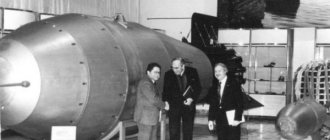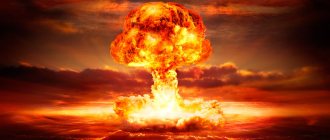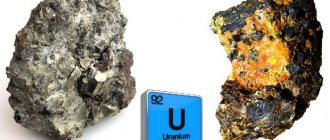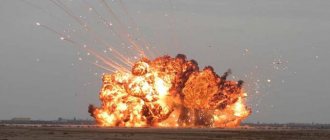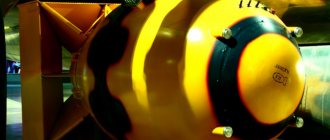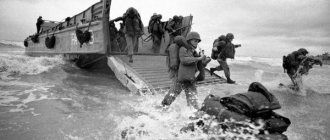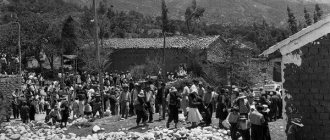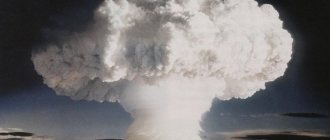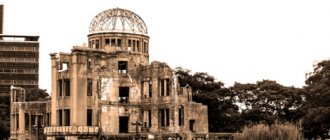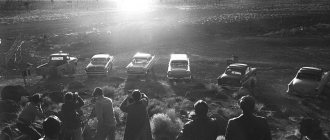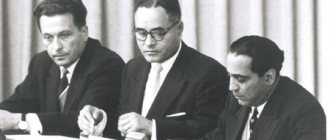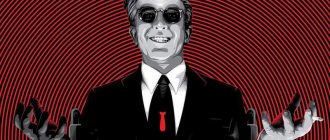Kurt Vonnegut, "Cat's Cradle"
It all started with a letter written in 1939 by three immigrant physicists - Leo Szilard, Eugene Wigner and Albert Einstein. The letter was addressed to the American President. It talked about a superweapon that could be created in Germany, and that America needed to get ahead of it. Seven years later, the project, which involved 130 thousand people, was successfully completed - after the deaths of many more people in Hiroshima and Nagasaki. However, the first atomic explosion did occur in America - at the Trinity test site in New Mexico. It happened on July 16, 1945, 60 years ago.
The Manhattan Project, as the military called the development of a nuclear bomb, is a rare case when almost half of the creators of all modern physics were occupied with one task. Most of them left Europe because their nationality was incompatible with the “new order” (or simply because they did not want to cooperate directly or indirectly with the Nazis) - and, therefore, they were united by a common interest. However, the scientists saw worthy rivals in the participants of the “German project” - and could not help but rush.
The formal leader of the project was General Leslie Groves, the actual leader was Robert Oppenheimer. Many participants - Albert Einstein, Niels Bohr, Enrico Fermi - had already received the Nobel Prize by that time, while others (Richard Feynman, Eugene Wigner, Hans Bethe, Glenn Seaborg, Luis Alvarez) were yet to do so. At the same time, they decided to isolate world-famous scientists from the rest of the world and gather them in Los Alamos.
The structure of the atom (and radioactive decay) has been actively studied since the early 1900s: the first Nobel laureates included Rutherford, who established the connection between radioactivity and nuclear transformations, and Marie Sklodowska-Curie, who first isolated artificial radioisotopes. The unusual amounts of energy that appeared in the decay equations suggested that they could be used for some destructive purpose. Frederic Joliot-Curie was the first to speak out about this, but the picture he painted had little in common with the fears of a society familiar with the nuclear bomb.
Schrödinger, Einstein, Bohr, Langmuir, Planck, Marie Curie, Lorentz, Langevin, Brillouin, Debye, Born, Picard, de Donde and others at the Fifth Solvay Congress in Brussels. Source: American Institute of Physics (AIP) website (click to enlarge)
Lenta.ru
According to Joliot, in the cycle of nuclear transformations of “everything into everything” one can find a “weak link” - and a spontaneous decay reaction will destroy the planet. “If someday a researcher finds a way to cause such a catastrophe, will he try to do such an experiment? I think that he will carry out this experiment, since the researcher is inquisitive and loves the risk of the unknown,” wrote Joliot-Curie, and this remark turned out to be more far-sighted than the physical concept that gave rise to it.
American explorers were inquisitive and loved the risk of the unknown, just as their French colleague foresaw. To the credit of physicists, connoisseurs of the result itself were a minority among them, and this is difficult to overestimate - thanks to the Manhattan Project, computers and quantum electrodynamics appeared, which were not directly related to the matter.
Winners
By July 1945, four bombs were ready - two plutonium and two uranium. The latter, simpler and weaker, decided to postpone until later, and the device (the bomb was called “Gadget”) with 6 kilograms of plutonium inside was delivered to the test site in the Jornado del Muerto desert (by the way, later another product of the advanced military was tested there technologies - V-2 rockets exported from Germany). No one knew the exact strength of the upcoming explosion: expert forecasts ranged from the pessimistic “nothing will happen” to the equally pessimistic “everything will burn up” - some believed that the bomb was capable of initiating a reaction during which the entire atmosphere of the Earth would burn out. The explosion did not live up to either one or the other expectations: its power was 18 thousand tons of TNT. Conventional ammunition rarely contained even one ton of explosive.
Future Nobel laureate Luis Alvarez called what he saw from the airplane window “a nuclear mushroom,” and this phrase became one of the key phrases in conversations about “the twentieth century in general.” But before myths began to take shape and fears were born, a little more time had to pass - the general public found out exactly what the new weapon could do in two weeks.
Nuclear weapons[edit]
Main articles: Nuclear weapons and History of nuclear weapons
Only two nuclear weapons were used in combat—both by the United States against Japan in World War II. The first event occurred on the morning of August 6, 1945, when the US Air Force dropped a uranium cannon-type device codenamed "Little Boy" on the city of Hiroshima, killing 70,000 people, including 20,000 Japanese combatants and 20,000 Korean slave owners. The second event occurred three days later when the US Air Force dropped a plutonium explosive device codenamed "Fat Man" on the city of Nagasaki. It killed 39,000 people, including 27,778 Japanese munitions workers, 2,000 Korean slaves, and 150 Japanese combatants . In total, these explosions killed approximately 109,000 people. (For a full discussion, see Atomic Bombings of Hiroshima and Nagasaki
).
Most governments view nuclear weapons as a "deterrent"; the sheer scale of destruction caused by nuclear weapons prevented their use in war. [ citation needed
]
Nuclear testing[edit]
Main article: Nuclear testing
Since the Trinity test, excluding combat use, nuclear-weapon countries have conducted approximately 1,700 nuclear explosions, all but six as tests. Of these, six were peaceful nuclear explosions. Nuclear tests are experiments conducted to determine the effectiveness, yield, and explosiveness of nuclear weapons. Throughout the 20th century, most countries that developed nuclear weapons tested them in stages. Testing of nuclear weapons can provide information about how they work, as well as how they perform under different conditions and how structures behave in a nuclear explosion. In addition, nuclear testing was often used as an indicator of scientific and military power, and many tests were explicitly political in nature; most nuclear powers have publicly declared their nuclear status through a nuclear test.
Losers
In addition to the Manhattan Project participants themselves, there was another group of physicists who did not fail to be informed before the first news release. Three Nobel laureates - Werner Heisenberg, the author of the uncertainty principle, Otto Hahn, the discoverer of uranium nuclear fission, and Max von Laue, the creator of X-ray spectroscopy - were met together on July 16, 1945, at the English estate Farm Hall, where they were taken by the American military. German scientists were arrested in the vicinity of Ehingen. During the war, the Kaiser Wilhelm Institute actually moved there and most of the theoretical physicists moved there.
The first nuclear bomb, photo from utexas.edu
Lenta.ru
Not only was the bomb being developed: a special department, supervised by two admirals, was supposed to create the world's first nuclear submarine. Germany already had a serious supply of uranium metal and heavy water, but, generally speaking, such a list of “ingredients” was not enough. The main task - isotope separation - was never fully solved, and plutonium was never isolated in a German laboratory.
Groves, an American general and the official head of the Manhattan Project, recorded the scientists' remarks when the tests were announced to them. It is curious that the developers of the atomic bomb for Germany did not have a consensus as to whether it was possible in principle to construct it, and they were sincerely surprised by what they heard. Later, both Heisenberg and Hahn explained their failure by deliberate sabotage of the project, and not at all by a lack of information. However, it is difficult to suspect them of insincerity - the philosopher Heisenberg or Hahn, who refused a direct offer to become a member of the Nazi Party, were hardly the most loyal people to the regime.
Consequences of nuclear explosions[edit]
Main article: Consequences of nuclear explosions
The dominant effects of nuclear weapons (explosion and thermal radiation) are the same physical damage mechanisms as conventional explosives, but the energy produced by a nuclear explosive is millions of times greater per gram and the temperatures achieved are in the tens of megakelvins. Nuclear weapons are very different from conventional weapons due to the enormous amount of explosive energy they can produce and the different types of effects they produce, such as high temperatures and nuclear radiation.
The destructive effects of the explosion do not stop after the first explosion, as with conventional explosives. A cloud of nuclear radiation moves from the hypocenter of the explosion, affecting life forms even after the heat waves have ceased.
Any nuclear explosion (or nuclear war) would have far-reaching, long-term catastrophic consequences. Radioactive contamination can cause genetic mutations and cancer over many generations. [5]
Western media: Stalin was personally present at the tests, the bomb exploded in Crimea
Historians and experts believe that the successful test of the Soviet atomic bomb prevented the Cold War from turning into a real one, acting as a deterrent. Interestingly, the West initially ignored the very fact of a successful Soviet explosion: the American and European media were silent about the Semipalatinsk test for almost a month (just remember how quickly, in contrast, the European media reacted to the accident in Chernobyl).
The conspiracy of silence was first broken by President Truman, who floridly announced this only on September 23, 1949: “We have information that in recent weeks an atomic explosion has occurred in the Soviet Union. Since atomic energy was released by man, one could expect the eventual development of this new power by other nations...” And he did not even mention that it was a bomb that exploded - apparently not daring to frighten the American people with this fact. But the statement itself also had the effect of an atomic bomb. The media, lost in conjecture, accused Truman of alarmism and inflating war psychosis (French newspaper L'Humanité), made assumptions that the explosion occurred on September 14 and either in the Crimea, or in Siberia (Reuters), that on Stalin himself was present at the test, and the first bombs were dropped near the Black Sea (New York Daily News).
Consequences of the creation of the atomic bomb in the Soviet Union
Several main consequences of the successful development of atomic weapons by Soviet scientists can be identified:
- Loss of the US status as a single state with atomic weapons. This not only equalized the USSR with the USA in terms of military power, but also forced the latter to think through each of their military steps, since now they had to fear for the response of the USSR leadership.
- The presence of atomic weapons in the USSR secured its status as a superpower.
- After the USA and the USSR were equalized in the availability of atomic weapons, the race for their quantity began. States spent huge amounts of money to outdo their competitors. Moreover, attempts began to create even more powerful weapons.
- These events marked the start of the nuclear race. Many countries have begun to invest resources to add to the list of nuclear weapons states and ensure their security.
“Total dirt and cockroaches”
The tests near Semipalatinsk were kept in the strictest confidence, but already on September 3, the Americans received information about a successful explosion. Analysis of air samples in the Kamchatka region, taken by a US meteorological intelligence service aircraft, showed the presence of isotopes indicating a nuclear explosion. On September 23, President Harry Truman announced what happened in the Kazakh steppe. The Americans were confident that the USSR would develop an atomic bomb no earlier than 1952, but not in 1949. Therefore, the tests at the Semipalatinsk test site took the Americans by surprise - now the USSR was equal to the USA in military power.
“The test results of the first atomic bomb RDS-1 (Russia Makes Itself), created in the USSR, were of particular importance,” notes the monograph “Semipalatinsk Test Site” edited by the famous radiochemist Vadim Logachev, published by the Federal Directorate of Medical-Biological and Extreme Problems Russian Ministry of Health in 1997. (Russia Does Itself is a comic decoding of the name of the bomb, popular among Soviet scientists. - Lenta.ru). “Firstly, only they could give a final answer to the question of the correctness of the approaches to the development of the projectile, which became the first domestic example of a new type of weapon based on the use of a fission chain reaction in a certain mass of nuclear explosive - plutonium-239. Secondly, the very fact of conducting such a test was of great political and military-strategic significance, consisting in the termination of the American monopoly on the possession of nuclear weapons and the emergence of the opportunity to ensure in the future military-defense parity of the two leading states of the world - the USSR and the USA."
Newsreel footage, 1951
Newsreel footage / Sputnik in Russian / YouTube
During the test, a curious incident occurred. The shock wave destroyed the metal cages, releasing white mice into the wild. They scattered across the Experimental Field. Nuclear scientists had to stop everything, catch the rodents and put them back in cages. What made the search easier was that the white mice were clearly visible against the background of the burnt grass.
There were plenty of other problems as well. Thus, physicist Evgeny Sbitnev called the conditions in Semipalatinsk fantastically bad:
Accommodation, food - everything was organized very poorly. Complete unsanitary conditions, dirt and cockroaches
Moreover, when carrying out the first experimental explosion, they decided to ignore unfavorable meteorological conditions and conduct the test in rainy weather with sharp gusts of wind. As a result, areas far beyond the test site were exposed to radioactive contamination. And the maximum dose recorded near the village of Dolon exceeded 200 roentgens.
In the early period of testing (1949-1951), no one was particularly interested in the safety of the population.
On October 18, 1951, the first aerial nuclear explosion occurred in Semipalatinsk: for the first time in the USSR, a nuclear bomb was dropped from an airplane. And in 1953, the most powerful land-based explosion took place. For security reasons, the authorities evacuated the population from the sector with a radius of 120 kilometers - they evicted 2,250 people and removed over 44 thousand heads of livestock. The military took them away in trucks. After the explosion, they decided to evacuate the residents of the village of Abay, which was in a zone of radioactive contamination. Of the 1,620 people, 191 were not taken out in time. They received radiation. The lack of experience during the first nuclear tests led to the loss of some information about the damaging factors of nuclear explosions.
191 people
received radiation after the most powerful explosion at the Semipalatinsk test site in 1953
Outside the Experimental Field, due to exposure to light radiation from a nuclear explosion, people lost their vision - burn injuries to the retina or temporary blindness. Sometimes this led to complete blindness.
In the 1950-1960s, it was believed that existing safety measures were sufficient, so residents of the areas adjacent to the test site were not warned in advance about the time of testing. This is how mistrust matured in people, which is why the anti-nuclear movement arose.
“This testing ground went through my family like a combine harvester,” says activist, otolaryngologist Yakubovskaya. — Mom passed away in 1953. She passed away in her prime due to cancer. I myself have been treated by hematologists and other specialists all my life. I didn't allow myself to give birth. I was forced to leave Semipalatinsk because I was in danger of becoming disabled. It is unlikely that anyone can say exactly how many people suffered then. There was a classification of secrecy. My mother died after surgery for stomach cancer. And on the death certificate they wrote: “acute heart failure.” According to the documents, a person should have died from anything, but not from diseases caused by radiation. They started talking about it out loud only when the Union collapsed
Links[edit]
- US Department of Energy. "Trinity Site - World's First Nuclear Explosion". Energy.gov Management Office
. Retrieved December 23 +2016. - ↑
Taylor, Alan (July 16, 2015).
"70 years since Trinity: the day the nuclear age began". Atlantic
. Retrieved December 23 +2016. - ↑
Groves, General Leslie (18 July 1945). "New Mexico's First Nuclear Test: Memorandum to the Secretary of War, Subject: Test". US War Department. PBS.org. Retrieved December 23 +2016. - Yang, Xiaoping; North, Robert; Romney, Carl; Richards, Paul G. (August 2000), Worldwide Nuclear Explosions (PDF), retrieved December 31, 2013.
- Malcolm Fraser and Tilman Ruff. 2015 is the year of the ban on nuclear weapons, The Age
, 19 February 2015.
“Railway and highway bridges were thrown back tens of meters, residential buildings were destroyed”
And the first successful test of an atomic bomb in the USSR on August 29, 1949, at 7 o’clock in the morning, finally happened. As a result, the USSR became the second nuclear power in the world after the USA, which largely determined relations between the countries for many years to come. The immediate consequences of the explosion were “monstrous”: railway and highway bridges were thrown tens of meters away, carriages with cars were scattered 50-80 meters across the steppe of Kazakhstan, residential buildings were destroyed, and so on. Delighted with the results, some time later the scientists made five more of the same bombs and placed them in Arzamas-16 for storage.
By the way, what many people forget, the second, Kurchatov’s sample of the bomb was tested later, almost immediately after the successful explosion of a bomb based on the American model - the tests were also successful. Many historians and experts explain the decision of USSR politicians and scientists to initially work cautiously and carry out tests based on American models in much the same way as Stalin’s Politburo: “Intelligence information made it possible not to be distracted by checking unpromising options already worked out by the Americans.” We could do it ourselves, but it would waste more time and nerves.
Semipalatinsk test site. After the test. Photo biblioatom.ru
Lake with monsters
In the 1950s and early 1960s, the world was shaken by hundreds of powerful nuclear and thermonuclear explosions - from a few kilotons to tens of megatons. This brought the planet to the brink of disaster. Underground explosions were recognized as the lesser of the evils in the current situation. On March 17, 1960, the Central Committee of the CPSU and the Council of Ministers of the USSR decided to carry out special mining operations for underground testing at the Semipalatinsk test site. Already in August, the excavation of special adits began in the strictest secrecy and far from supply bases in the Degelen Mountains.
Just a year later, on October 11, 1961, an underground test took place. Vitaly Bakhardin, a participant in the first explosions, recalled that the atomic charges were not placed deep underground, but inside the mountain. To do this, a horizontal, very straight adit was laid at its base, which ended under the top. It was opened by civilian miners who had undergone a thorough KGB check. They drilled deep holes in the rock, planted explosives in them and blew them up. The bumps ruled the jackhammers. In this way, a “hole” was made in the mountain, up to a kilometer long, three meters wide and high.
It was possible to establish that a nuclear explosion differs significantly in its consequences from an experimental TNT explosion: there were no such noticeable cracks through which large volumes of gases would escape. There was also no need to use an insulating gas mask in the adit. Three to four hours after the explosion, radioactive inert gases began to disappear at its epicenter.
Semipalatinsk nuclear test site, 1961
Photo: Andrey Solomonov / RIA Novosti
The second underground nuclear explosion took place on February 2, 1962, with the same characteristics as the American Blanca explosion. However, test participants saw significant differences: there was no release of radioactive gases into the atmosphere and no formation of a sinkhole. It became clear that the consequences of an underground nuclear explosion mainly depend on the characteristics of the rock and mainly on its moisture and gas content.
This is what the explosion looked like through the eyes of serviceman Bakhardin: “As if sighing, the mountain swelled slightly and immediately settled down. The snow lying on her sides fell down, but not all of it. For some reason, hot gases escaped from the thickness of the mountain only through its top; the snow cap lying on it instantly turned into steam. “Puff!” - and a white steam cloud rushed from the top of her head into the sky, and she herself suddenly immediately became whitish. Precisely whitish, because all the stones lying on it from the high temperature and water vapor immediately took on the same color as the stones in a Russian steam bath. But the consequences of the explosion did not end there. Ten seconds passed, or maybe more, and all the inhabitants of point “G” felt a rather strong vibration of the earth - an artificial earthquake.”
The era of aerial testing soon became a thing of the past. Khrushchev and US President John Kennedy agreed that only underground tests of no more than 10 megatons were possible. On October 10, 1963, the Moscow Treaty “On the Prohibition of Tests of Nuclear Weapons in the Atmosphere, Outer Space and Under Water” came into force. One of his demands was that after a nuclear explosion in the bowels of the earth there should be no fallout of radioactive fallout outside the state that carried out the tests.
For some reason, there were discrepancies in the two language copies. Thus, the Russian version prohibited underground nuclear explosions leading to the appearance of “radioactive fallout,” while the English text prohibited underground nuclear explosions leading to the appearance of “fragments.” Both texts had equal legal force. Two interpretations of the treaty emerged, and the Americans sometimes tried to make claims of treaty violation against the Soviet Union using the English text. The USSR, of course, rejected these claims.
For underground nuclear explosions, the boundaries of the exclusion zone of the test site were expanded. In this territory, later, as a result of an underground nuclear explosion, an artificial reservoir appeared at the confluence of the Chagan and Ashchi-Su (Ashchysu) rivers - Lake Chagan, or, as the Kazakhs called it, Atom-Kol (Atomic Lake). The first to swim in it was the Minister of Medium Engineering and one of the initiators of the Chagan project, Efim Slavsky. However, almost no one followed his example. To this day, local residents are afraid to fish there, and shepherds drive their flocks to watering in one specific place. Fishermen tell stories about monsters more than two meters long and fish with glowing heads.
"Atomic Lake", 1988
Photo: Dmitry Sokolov / TASS
Selected by Beria as curator, Kurchatov began an atomic project in Kazan
A number of historians believe that the description of the first US atomic bomb was obtained in Moscow thanks to Soviet intelligence officers 12 days after the completion of assembly. By the way, the atomic project was supervised by Lavrentiy Beria himself. And the first nuclear laboratory in the USSR, as we already wrote in our analytical material on the Russian nuclear industry, actually appeared in Kazan. In 1942, the State Defense Committee of the USSR ordered the start of work on uranium, organizing for this purpose at the Academy of Sciences “a special laboratory of the atomic nucleus, the creation of laboratory facilities for the separation of uranium isotopes and a complex of experimental work.” The order obligated the Council of People's Commissars of the Tatar Autonomous Soviet Socialist Republic to provide the USSR Academy of Sciences in Kazan with “rooms of 500 square meters. m to accommodate an atomic nuclear laboratory and living space for 10 researchers."
Under the leadership of Igor Kurchatov himself, who later became known as the “father” of the Soviet atomic bomb, work on the study of nuclear reactions has been carried out in Kazan since 1943. Their main task was to create nuclear weapons. Premises with an area of 500 sq. m. became Laboratory No. 2, later the National Research Center “Kurchatov Institute”. Kurchatov was chosen by Beria himself from among 50 candidates; he had to meet the requirements of Joseph Stalin: “We must find a talented and relatively young physicist so that solving the atomic problem becomes the only work of his life. And we will give him power, make him an academician and, of course, we will vigilantly control him.” Kurchatov worked in Kazan in 1942-1943, after which - when the danger of the capture of Moscow by the Germans had passed - he left for the capital of the USSR, and Laboratory No. 2 also moved there.
The first domestic atomic bomb RDS-1 in the Museum of Nuclear Weapons RFNC-VNIIEF. Photo by Vladimir Kharkevich / panoramio.com
